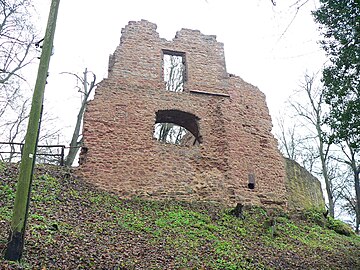Rauschenberg Castle (Hesse)
| Rauschenberg Castle | ||
|---|---|---|
| Alternative name (s): | Rauschenberg Castle (1597–1646) | |
| Creation time : | around 1000 to 1100 | |
| Castle type : | Hilltop castle | |
| Conservation status: | ruin | |
| Standing position : | Count | |
| Place: | Rauschenberg | |
| Geographical location | 50 ° 52 '56.9 " N , 8 ° 54' 35.6" E | |
| Height: | 324 m above sea level NN | |
|
|
||
The castle Rauschenberg , and Schloss Rauschenberg called, is the ruins of a medieval hilltop castle at around 324 m above sea level. NHN on a summit above the town of Rauschenberg in the Hessian district of Marburg-Biedenkopf .
history
The castle was probably built in the 11th / 12th centuries. Built in the 18th century by order of the Abbey of Fulda . The castle was first mentioned in 1219 when it was at least administered by the Fritzlar canon Conrad von Rauschenberg, who was probably the castle man there. The castle and place were the seat of the Ziegenhain district of Rauschenberg and at times also the widow seat of the Ziegenhain count widows. After the death of Count Gottfried IV († 1250) in Nidda and Berthold I († 1258) in Ziegenhain, there was an inheritance dispute between their sons in 1258. This led to the formal division of the two counties and an exchange of territory in 1258, mediated by Abbot Heinrich IV of Fulda, who at the same time was also Abbot of Hersfeld and thus liege lord of the Ziegenhainers for both Nidda and Ziegenhain. Rauschenberg Castle went to Berthold's son Gottfried V , whose widow Hedwig von Castell († after 1291) called herself "Countess von Rauschenberg" after his death in 1271. In 1304 she married the Falkenstein - Münzenberg Count Philipp and half of the castle then came to Falkenstein-Münzenberg until 1399. In 1434 it became a Ziegenhainer fiefdom of Landgrave Ludwig I of Hesse . After 1450, when the county of Ziegenhain fell to the Hessian landgrave as heir after the death of Count Johann II , the castle was used as a hunting lodge . The widow of the last Count of Ziegenhain, Elisabeth von Waldeck , had the right to live in the castle for life.

The second eldest son of Landgrave Heinrich III died there in hunting accidents in 1478 . of Upper Hesse , Ludwig III. at the age of only 17 and 1500 Ludwig's younger brother, Wilhelm III. , since 1483 successor of the father in the Landgraviate of Upper Hesse.
From 1594 to 1597 the castle was expanded into a landgrave's palace. Looted by the Swedes in the Thirty Years' War in 1639 , the castle was blown up in 1646 at the behest of a colonel from Hessen-Kassel . The rubble was partially removed in 1830.
Appearance
The former building was based on an almost circular complex, but was bordered by an angular curtain wall . A keep , at least two main buildings ( palas ) and several small outbuildings were part of the core of the castle. After the destruction, only the remains of rubble cones from the keep, parts of the wall of a three-storey residential building with various remains of vaults and a barrel-vaulted cellar remained. There are no visible relics of the conversion to the castle.
literature
- Rudolf Knappe: Medieval castles in Hessen. 800 castles, castle ruins and fortifications. 3. Edition. Wartberg-Verlag, Gudensberg-Gleichen 2000, ISBN 3-86134-228-6 , p. 262 f.
- Rolf Müller (Ed.): Palaces, castles, old walls. Published by the Hessendienst der Staatskanzlei, Wiesbaden 1990, ISBN 3-89214-017-0 , p. 292.




